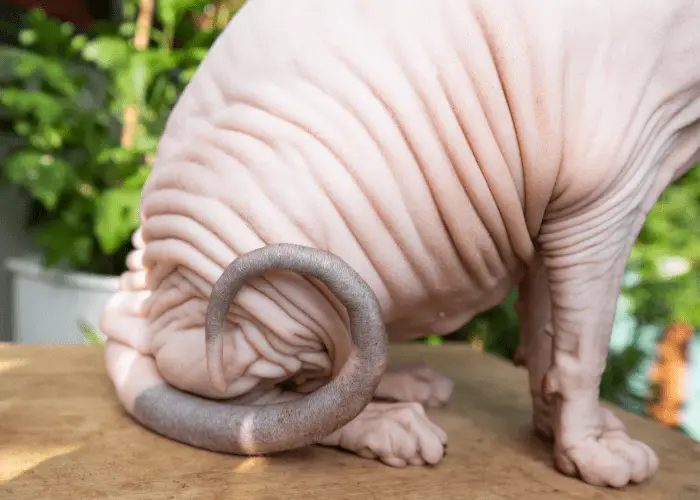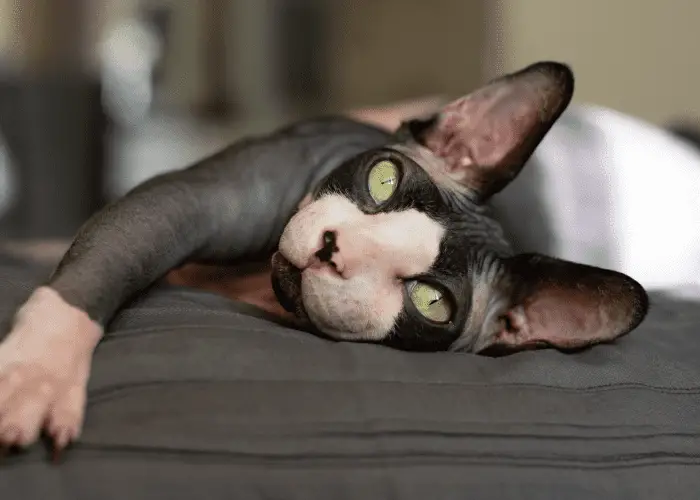This article contains affiliate links, and we may earn a commission at no cost to you if you choose to purchase through these links. I never recommend products that I do not trust or will not advise my veterinary clients and patients to use.

An intolerance to chicken protein is among the most common causes of food sensitivities in dogs and cats. Food sensitivities often manifest in skin and digestive symptoms. Since sphynx cats have both sensitive skin and digestive systems, they may be more likely to show signs of food sensitivities.
In short: there is no significant evidence that sphynx cats are more prone to chicken allergy than other cat breeds. However, some physiological attributes in the sphynx cat may exacerbate the symptoms of a chicken (food) allergy.
Chicken protein is probably the most cost-effective source of animal protein and finds its way into most pet diets. Diagnosing a chicken allergy is not always straightforward, but treating an allergy to chicken may be as simple as a diet change.
Food Allergies In Sphynx Cats
Food hypersensitivity (allergy) is an adverse immune response to the food or an additive in the food. The reaction to the foodstuff or food additive is usually in response to the protein component of the food, such as chicken, pork, beef, turkey, or plant proteins found in corn or wheat, to name a few.
In simple terms, when an animal with a food sensitivity ingests an offending protein, the immune system mounts a response to ‘attack’ the protein in question by initiating an inflammatory process. The inflammation caused by this immune response causes the dermatological and digestive symptoms associated with a food allergy.
The sphynx cat has to compensate for the lack of hair by having a high metabolism to control the body’s temperature. This means that the sphynxes eat a larger volume of food and eat more frequently throughout the day. Consuming the offending food component more regularly or in higher quantities may worsen the symptoms or appear more persistently.
Pet Vet Tips: Why are Sphynx cats always hungry? Read the article explaining the high metabolism of sphynx cats.
Since sphynx cats are hairless, the dermatological manifestation of the food allergy symptoms will appear more prominently on the skin than in a cat covered in hair. Sphynx cats also have oily and sensitive skin, which can slightly compromise the skin barrier. Therefore, irritation to the skin that leads to excessive licking or scratching will most likely aggravate the skin lesions quicker and more severely as there is no hair to add some protection to the skin.
Pet Vet Tip: For more information on common skin conditions of sphynx cats and how to care for their skin and ears, have a look at helpful articles linked here.
What Are The Signs Of Food Allergy In Sphynx Cats?
If your cat has a food allergy, the signs will be exhibited on the skin and the digestive system. Cats will mostly present with either dermatological or gastrointestinal symptoms, and rarely, both.
Other organ systems may also be affected but to a lesser extent. These symptoms can occur anywhere on the spectrum, ranging from slightly noticeable to severe and demanding immediate attention.
Dermatological Symptoms:
- Scratching excessively around the neck, eyes, and ears
- Licking excessively – especially the legs, paws, and belly
- Rash around the ears and face – the ears may appear very red and will be itchy
- Raised bumps on the skin
Gastrointestinal Symptoms:
- Diarrhea (chronic soft or runny but not watery stool)
- Vomiting (more than three times a week is a good guideline to go by)
- Weight loss
How Can A Chicken Allergy Be Confirmed?
A food allergy is most commonly and accurately diagnosed through a food elimination trial; however, any other concurrent skin diseases, such as a secondary bacterial or yeast skin infection or skin parasites, need to be treated before the response to a diet trial can be accurately assessed.
Your vet will be able to help you appropriately treat and prevent concurrent skin diseases that may result from a compromised skin barrier due to a food allergy.
It is important to note that many other possibilities may be affecting your cat that might cause similar symptoms, especially in the skin. For example, ectoparasites, skin infections such as Malassezia dermatitis, immune-mediated diseases, skin cancers, behavioral abnormalities (excessive licking or nibbling), trauma, or bite wounds.
Pet Vet Tip: A compromised skin barrier, as is the case with an allergic skin reaction, is more prone to skin infections, including infection by normally occuring yeasts on the skin of sphynx cats. For more information on Malassezia dermatitis, the treatment and prevention thereof, have a look at our Malasseizia dermatitis care guide.
Food Elimination Trial
Two categories of elimination or hypoallergenic diets are used in the dietary elimination trial: novel protein diets and hydrolyzed protein diets.
Novel Protein Diets
Examples of novel proteins (proteins from sources not previously eaten by your cat) include venison, rabbit, goat, kangaroo, pork, ostrich, duck, lamb, and fish.
Meat from species taxonomically related to the triggering food may cause cross-reactivity and should be avoided. For example, chicken, dove, duck, turkey, and quail have common allergens like chicken, so your commercial novel protein diet should not contain these if a chicken allergy is suspected.
Some examples of novel protein or non-chicken protein diets are Orijen Regional Red (beef, pork, mackerel, lamb, etc.) and Orijen Six Fish (mackerel, herring, flounder, and other fish species) or Blue Buffalo Novel Protein diet (alligator protein).
Hydrolyzed protein diets
In hydrolyzed protein diets, the protein structure is disrupted by breaking the peptide bonds in the amino acid chains to create smaller fragments. This results in a smaller molecular weight of the original protein, reduce antigenicity and allergenicity, and may increase digestibility.
Examples of hydrolyzed protein diets include Purina Pro Plan HA, Hill’s z/d, and Royal Canin Hydrolyzed Protein diet.
Note that some of the example diets mentioned above may still list chicken as a protein; however, the protein has been broken down into fragments that are too small for the immune system to recognize, making these diets hypoallergenic.
The process whereby protein is broken down into lower molecular weight components is costly, and chicken protein remains one of the cheapest protein sources. Chicken protein is still used in these cases to make hydrolyzed protein and hypoallergenic diets more affordable to pet owners.
How Long Does A Diet Trial Last?
A diet trial should be at least eight weeks to give the body time to adjust to the new diet and for the chronic inflammation previously caused by the allergen to subside. Some cats show improvement within a few weeks, while others may take much longer to respond to the diet change.
Important Note While Implementing A Trial Diet
While your cat is on an elimination diet, it is of utmost importance that the diet is strictly adhered to and that no other foodstuffs be given to your cat. During this time, you may not feed your cat any treat, no human food (such as snacks or other foods outside of your prescribed home-cooked diet), and no flavored medications.
Accidentally providing the offending protein in the food, even in the tiniest quantities, will invalidate the test, and the test will have to be started from scratch.
If the symptoms your cat initially presented with improving or go away entirely after the food trial, a presumptive diagnosis can be made – your cat has a food allergy! Once a chicken allergy has been confirmed, the prognosis is good, provided chicken and chicken by-products are entirely avoided in the diet.
A successful diet trial can only be done if other secondary or concurrent skin conditions, such as infections, ectoparasites, or other immune-mediated diseases, are treated.
What About Intradermal Allergen Testing?
Intradermal allergen testing is done by injecting small amounts of possible allergens (not just a couple- some tests may do up to 60 different allergens simultaneously) and measuring the localized skin reaction to these allergens.
Unfortunately, intradermal skin allergen testing results are often ambiguous at best and notoriously unreliable when it comes to diagnosing food allergies.
Not only is this a costly test to run with unreliable results, but intradermal allergen testing is uncomfortable (imagine 60 skin injections and having many of those injection sites become itchy or inflamed due to a mild immune response).
The only area where intradermal allergen testing may have a valuable role is in diagnosing and treating environmental allergens, as the results may be used to create an Allergen Specific Immunotherapy. Unfortunately, this is not an effective therapy for food allergies, as simply avoiding the offending protein is far more effective at managing allergy symptoms.
What Should I Feed My Sphynx If They Are Allergic To Chicken?
Since a vast majority of cat food consists of chicken, the best option would be to exclusively feed your cat hypoallergenic pet food as these foods either do not contain the ingredients your cat is allergic to or have hydrolyzed versions of the element, which may not cause any allergic reaction.
The diets mentioned in the section on a food elimination trial are all excellent and safe long-term diet options. However, always consult your vet first before changing the diet of your Sphynx with food sensitivity.
Final thoughts
No skin condition has a quick fix, and even less so do immune-related conditions. Diagnosis and treatment often take many weeks, and signs and symptoms are often ambiguous. A diagnosis of a food allergy is not easily made, and therefore, the value of a trusted veterinarian can not be underestimated.
Please speak to your vet if your sphynx is suffering from digestive or dermatological symptoms and if you suspect a food allergy. Chicken is definitely a common culprit, but simply avoiding chicken may not always resolve all the symptoms unless secondary skin conditions are treated as well. Together you and your vet can help your sphynx to be free of pesky allergy symptoms.

Resources
- Genovese, D., Johnson, T., Lamb, K. and Gram, W., 2014. Histological and dermatoscopic description of sphynx cat skin. Veterinary Dermatology, [online] 25(6), pp.523-e90.
- Hunter, T. and Ward, E., 2022. Allergies in Cats | VCA Animal Hospital
- Jill L. Abraham, Chapter 28 – Feline Food Allergy, Editor(s): Susan E. Little, August’s Consultations in Feline Internal Medicine, Volume 7, W.B. Saunders, 2016, Pages 307-316,
- Rosser, E.J. (1997) “Food Hypersensitivity: New Recommendations for Diagnosis and Management,” in Consultations in Feline Medicine. Philadelphia, Pennsylvania: W.B Saunders Company, pp. 209–213.

